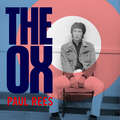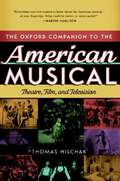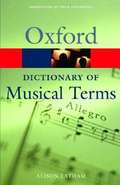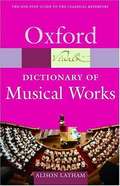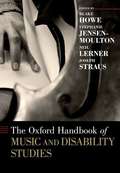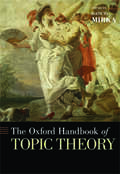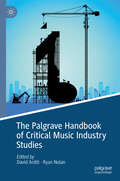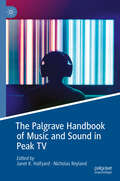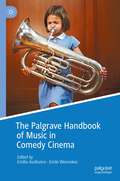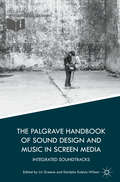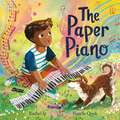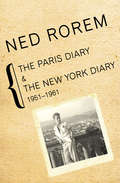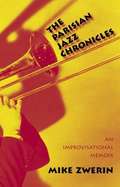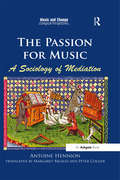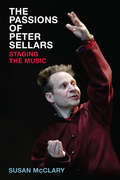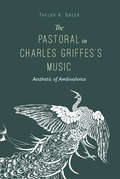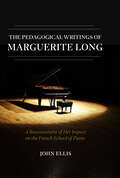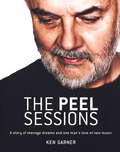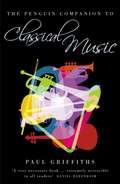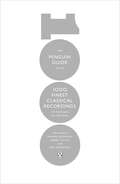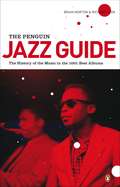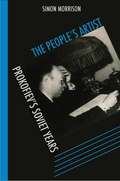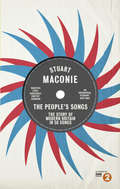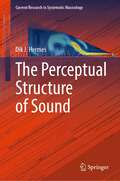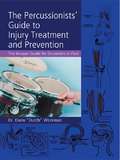- Table View
- List View
The Ox: The Last of the Great Rock Stars: The Authorised Biography of The Who's John Entwistle
by Paul Rees'A highly entertaining read' The Times Music Books of the Year'Eye-popping' The Times best summer booksThe definitive no-holds-barred biography of John Entwistle, The Who's legendary bass guitaristIt is an unequivocal fact that in terms of rock bands, the Beatles, the Rolling Stones and the Who represent Year Zero; the beginning of all things, ground-breakers all. To that end, John Entwistle - the Who's beloved bassist - is also without question one of the most important and influential figures in the annals of rock. He is also among an even more rarefied few by virtue of his being such a fascinating, transfixing and gloriously oversized character. However, Entwistle has not been the subject of a major biography. Likely, this was due to no-one being able to gain close access to the subject himself: the still in many other respects enigmatic Entwistle's enduring legacy has been carefully guarded by his surviving family. With the full co-operation of the Entwistle family, The Ox will correct this oversight and in doing so, shine a long overdue light on one of the single greatest, and most impactful figures in rock history.Drawing on his own notes for an unfinished autobiography that he started before his death in 2002 (and which will be quoted from extensively), as well as his personal archives and interviews with his family and friends, The Ox will give readers a never-before-seen glimpse into the two very distinct poles of John Entwistle. On the one hand, he was the rock star incarnate, being larger than life, self-obsessed to a fault, and proudly and almost defiantly so. Extravagant with money, he famously shipped two vintage American cars across the Atlantic without having so much as a driver's license, built exponentially bigger and grandiose bars into every home he owned, and amassed an extraordinary collection of possessions, from arachnids, armor, and weaponry, to his Cuban-heeled boots. But beneath this fame and flutter, he was also a man of simple tastes and traditional opinions. He was a devoted father and family man who loved nothing more than to wake up to a full English breakfast, or to have a supper of fish, chips, and a pint at his local pub.After his untimely death, many of these stories were shuttered away into the memories of his family, friends, and loved ones, but now, for the first time, The Ox will introduce us to the man behind the myth-the iconic and inimitable John Entwistle.
The Oxford Companion to the American Musical: Theatre, Film, and Television
by Thomas S. HischakFrom the silver screen to the Great White Way, small community theatres to television sets, the musical has long held a special place in America's heart and history. Now, in The Oxford Companion to the American Musical, readers who flocked to the movies to see An American in Paris or Chicago, lined up for tickets to West Side Story or Rent, or crowded around their TVs to watch Cinderella or High School Musical can finally turn to a single book for details about them all. For The first time, this popular subject has an engaging and authoritative book as thrilling as the performances themselves. With more than two thousand entries, this illustrated guide offers a wealth of information on musicals, performers, composers, lyricists, producers, choreographers, and much more. Biographical entries range from early stars Fred Astaire, Bing Crosby, Mary Martin, and Mae West to contemporary show-stoppers Nathan Lane, Savion Glover, and Kristin Chenoweth, while composers Irving Berlin, George Gershwin, Richard Rodgers, and Andrew Lloyd Webber all have articles, and the choreography of Bob Fosse, Tommy Tune, and Debbie Allen receives due examination. The plays and films covered range from modern hits like Mamma Mia! and Moulin Rouge! to timeless classics such as Yankee Doodle Dandy and Show Boat. Also, numerous musicals written specifically for television appear throughout, and many entries follow a work--Babes in Toyland for example--as it moves across genres, from stage, to film, to television. The Companion also includes cross references, a comprehensive listing of recommended recordings and further reading, a useful chronology of all the musicals described in the book, plus a complete index of Tony Award and Academy Award winners. Whether you are curious about Singin' in the Rain or Spamalot, or simply adore The Wizard of Oz or Grease, this well-researched and entertaining resource is the first place to turn for reliable information on virtually every aspect of the American musical. THOMAS HISCHAK is Professor of Theatre at the State University of New York College at Cortland. He is the author of sixteen books on theatre, film, and popular music, including The Oxford Companion to American Theatre; the textbook Theatre as Human Action; and the award-winning American Musical Theatre Song Encyclopedia. He is also the author of twenty published plays.
The Oxford Dictionary of Musical Terms
by Alison LathamPrinted music and writing about music involve the use of complex systems of notation and a wealth of technical terms in several languages. The Concise Oxford Dictionary of Musical Terms provides clear, succinct, definitions of a comprehensive range of the musical terms, in English and other European languages, that are likely to be encountered in Western music, including in jazz and popular musical genres. Over 2,500 A-Z entries range across a spectrum of subjects, among them: rhythm, metre, forms, genres, pitch, scales, chords, harmony and counterpoint, notational systems, composition and analysis, performance practice, tempo, expression, musical periods, artistic movements, computer applications, acoustics, and many more. Entries provide etymologies, and are fully cross-referenced. Some are illustrated with music examples and tables. An appendix lists all composers mentioned in the Dictionary, with their dates. It is an ideal book for students and teachers of music - it covers all the terms required in the SMAB musical theory exams - as well as for professional musicians, those learning to play musical instruments, and members of choirs, and musical groups. It will also be a useful quick reference book for concert-goers, CD-collectors, and radio listeners.
The Oxford Dictionary of Musical Works
by Alison LathamAnyone who listens to or plays classical music often wants to put the pieces they encounter in context - to check information ranging from who wrote the piece, or the date of its first performance, to how it acquired its title, or whether it was commissioned for a specific person or occasion.General dictionaries of music only cover a limited number of musical works, and include very little detail. The new Oxford Dictionary of Musical Works provides short articles on over 1750 musical works from earliest times to the present day, providing a comprehensive but handy reference. Entries encompass a broad spectrum of genres - from opera, ballet, choral and vocal music, orchestral, chamber and instrumental pieces, to nicknamed works, collections, national anthems, hymn tunes, and traditional melodies. Each entry outlines the genre to which the piece belongs; the librettist or author of the text, including any literary source; the number of acts or movements; the scoring - including details of the instrumentalists and vocalists needed to perform the piece; how it came to be commissioned; the place and date of its first performance; any subsequent arrangements or revisions; and any additional important or entertaining information.
The Oxford Handbook of Music and Disability Studies
by Joseph Straus Blake Howe Stephanie Jensen-Moulton Neil LernerThe Oxford Handbook of Music and Disability Studies represents a comprehensive state of current research for the field of Disability Studies and Music. The forty-two chapters in the book span a wide chronological and geographical range, from the biblical, the medieval, and the Elizabethan,through the canonical classics of the eighteenth and nineteenth centuries, up to modernist styles and contemporary musical theater and popular genres, with stops along the way in post-Civil War America, Ghana and the South Pacific, and many other interesting times and places. Disability is a broad, heterogeneous, and porous identity, and that diversity is reflected in the variety of bodily conditions under discussion here, including autism and intellectual disability, deafness, blindness, mobility impairment often coupled with bodily difference, and cognitive and intellectual impairments. Amid this diversity of time, place, style, medium, and topic, the chapters share two core commitments. First, they are united in their theoretical and methodological connection to Disability Studies, especially its central idea that disability is a social and cultural construction. Disability both shapes and is shaped by culture, including musical culture. Second, these essays individually and collectively make the case that disability is not something at the periphery of culture and music, but something central to our art and to our humanity.
The Oxford Handbook of Topic Theory
by Danuta MirkaTopics are musical signs developed and employed primarily during the long eighteenth century. Their significance relies on associations that are clearly recognizable to the listener with different genres, styles, and types of music making. Topic theory, which is used to explain conventional subjects of musical composition in this period, is grounded in eighteenth-century music theory, aesthetics, and criticism while drawing also from music cognition and semiotics. The concept of topics was introduced by Leonard Ratner in the 1980s to account for cross-references between eighteenth-century styles and genres. As the invention of a twentieth-century academic, topic theory as a field is comparatively new, and The Oxford Handbook of Topic Theory provides a much-needed reconstruction of the field's aesthetic underpinnings. The volume grounds the concept of topics in eighteenth-century music theory, aesthetics, and criticism. Documenting the historical reality of individual topics on the basis of eighteenth-century sources, it traces the origins of topical mixtures to transformations of eighteenth-century musical life and relates topical analysis to other methods of music analysis conducted from the perspectives of composers, performers, and listeners. Focusing its scope on eighteenth-century musical repertoire, The Oxford Handbook of Topic Theory lays the foundation for further investigation of topics in music of the nineteenth, twentieth, and twenty-first centuries.
The Palgrave Handbook of Critical Music Industry Studies
by David Arditi Ryan NolanThe Handbook of Critical Music Industry Studies provides students and researchers with the means to think about how the performance, recording, and publishing of music could be if we do things differently. People are hungry for a more equitable music performance and recording system. The industry exudes patriarchy, white supremacy, cultural imperialism, ableism, and worker exploitation. In the context of gendered (e.g., #MeToo and #TimesUp) and racialized (e.g., Black Lives Matter) inequity, rampant precarity and casualization, and modes of musical dissemination that are changing faster than policymakers and regulatory bodies can keep up with, the timing for assembling such an interdisciplinary collection could not be more appropriate. Essays in this handbook will tackle power structures at root in the music industry and the academic study of the field. Topics covered include the politics of representation and power in the global music industries, the labor of music, music as media (including data and algorithmic culture), and copyright/intellectual property, among others.
The Palgrave Handbook of Music and Sound in Peak TV
by Janet K. Halfyard Nicholas ReylandThe Palgrave Handbook to Music and Sound in Peak TV charts the transformation of television’s sonic storytelling during the new “golden age” of televisual narrative from the late 1990s to the early 2020s. Grounded in close analytical, critical, and theoretical work identifying the key traits of music and sound in this “peak TV” period, the book casts its critical net wider to develop interpretations of significance not just for screen music studies and musicology, but for screen and media studies too. By theorizing “peakness” with respect to sound and music, and by drawing together contributions from a diverse collection of prominent musicologists, media scholars, and practitioners, this handbook provides the authoritative guide to the role music has played in creating the success of some of the most culturally and commercially significant popular art of the early twenty-first century. The volume contains 25 essays in three main sections—Concepts and Aesthetics, Practices and Production, and Audiences and Interpretations. Topics discussed include peakness, complexity, ostentatious scoring, antiheroes, memory, franchises, worldbuilding, nostalgia, maternity, trauma, actor’s voices, title sequences, library music, branding, queer/camp scoring, kids TV, captioning, industry practices, HBO, and sound design. Shows examined include The Sopranos, The Wire, Game of Thrones, Battlestar Galactica, Westworld, Buffy the Vampire Slayer, Stranger Things, The Bridge, Dexter, Killing Eve, Mad Men, American Horror Story, Rings of Power, Fargo, Peaky Blinders, Call the Midwife, Twin Peaks, and Twin Peaks: The Return.
The Palgrave Handbook of Music in Comedy Cinema
by Emilio Audissino Emile WennekesThis handbook tackles the understudied relationship between music and comedy cinema by analysing the nature, perception, and function of music from fresh perspectives. Its approach is not only multidisciplinary, but also interdisciplinary in its close examination of how music and other cinematic devices interact in the creation of comedy. The volume addresses gender representation, national identities, stylistic strategies, and employs inputs from cultural studies, musicology, music theory, psychology, cognitivism, semiotics, formal and stylistic film analysis, and psychoanalysis. It is organised in four sections: general introductions, theoretical investigations, music and comedy within national cinemas, and exemplary case studies of films or authors.
The Palgrave Handbook of Sound Design and Music in Screen Media
by Liz Greene Danijela Kulezic-WilsonThis book bridges the existing gap between film sound and film music studies by bringing together scholars from both disciplines who challenge the constraints of their subject areas by thinking about integrated approaches to the soundtrack. As the boundaries between scoring and sound design in contemporary cinema have become increasingly blurred, both film music and film sound studies have responded by expanding their range of topics and the scope of their analysis beyond those traditionally addressed. The running theme of the book is the disintegration of boundaries, which permeates discussions about industry, labour, technology, aesthetics and audiovisual spectatorship. The collaborative nature of screen media is addressed not only in scholarly chapters but also through interviews with key practitioners that include sound recordists, sound designers, composers, orchestrators and music supervisors who honed their skills on films, TV programmes, video games, commercials and music videos.
The Paper Piano: An inspirational picture book for music lovers
by Rachel IpWhen Noah hears beautiful piano music sweeping through the station, he longs to play. Without a pianoof his own, he carefully crafts one out of paper, and the notes fill his head night and day. Until finally, with the help of a neighbour, his musical dream comes true . . .An inspirational picture book about the power of perseverance and music, celebrating the joy that railway station pianos can bring to all. Written by award-winning author Rachel Ip, with artwork from award-winning illustrator Natelle Quek.
The Paris Diary & The New York Diary, 1951–1961: 1951-1961
by Ned RoremIn the earliest published diaries of Ned Rorem, the acclaimed American composer recalls a bygone era and its luminaries, celebrates the creative process, and examines the gay culture of Europe and the US during the 1950sOne of America&’s most significant contemporary composers, Ned Rorem is also widely acclaimed as a diarist of unique insight and refreshing candor. Together, his Paris Diary, first published in 1966, and The New York Diary,which followed a year later, paint a colorful landscape of Rorem&’s world and its famous inhabitants, as well as a fascinating self-portrait of a footloose young artist unabashedly drinking deeply of life. In this amalgam of forthright personal reflections and cogent social commentary, unprecedented for its time, Rorem&’s anecdotal recollections of the decade from 1951 to 1961 represent Gay Liberation in its infancy as the author freely expresses his open sexuality not as a revelation but as a simple fact of life. At once blisteringly honest and exquisitely entertaining, Rorem&’s diaries expound brilliantly on the creative process, following their peripatetic author from Paris to Morocco to Italy and back home to America as he crosses paths with Picasso, Cocteau, Gide, Boulez, and other luminaries of the era. With consummate skill and unexpurgated insight, a younger, wilder Rorem reflects on a bygone time and culture and, in doing so, holds a revealing mirror to himself.
The Parisian Jazz Chronicles: An Improvisational Memoir
by Mike ZwerinThis book is built around a structure that treats such subjects of my music column in the International Herald Tribune as Dexter Gordon, Freddy Heineken, Miles Davis, Bob Dylan, Chet Baker, and Melvin Van Peebles as though they were the written notes in big band arrangements.
The Passion for Music: A Sociology Of Mediation (Music And Change: Ecological Perspectives Ser.)
by Antoine HennionMusic is an accumulation of mediators: instruments, languages, sheets, performers, scenes, media and so on. There is no musical objectin itself ; music must always be made again. In this innovative book, Hennion turns the elusiveness of music into a resource for a pragmatic analysis: by which collective process do we make music appear among us? Rather than offering a sociology of music, The Passion for Music listens to the lesson provided by the case of music - this art of infinite mediations. Learning from music allows us to transform the paradigm to be offered by sociology, by confronting it (from Durkheim and Weber to Bourdieu) with a different way of considering objects. For this task, Hennion draws on aesthetics (Adorno) and art history (Haskell, Baxandall), as well as science and technology studies and popular music studies (Latour, Frith, DeNora). As part of that project, The Passion for Music presents a wide-ranging series of case studies, restoring attention to the rich and varied intermediaries through which music is brought to life: from the debate around the reinterpretation of baroque music, to the classroom, the rock scene, the classical music concert, Bach‘s ‘social career in the nineteenth and twentieth centuries, and the practices of musicamateurs today. This is the first English translation of one of the most important works of French scholarship on music and society.
The Passions of Peter Sellars: Staging the Music
by Susan McClaryRecognized as one of the most innovative and influential directors of our time, Peter Sellars has produced acclaimed—and often controversial—versions of many beloved operas and oratorios. He has also collaborated with several composers, including John C. Adams and Kaija Saariaho, to create challenging new operas. The Passions of Peter Sellars follows the development of his style, beginning with his interpretations of the Mozart-Da Ponte operas, proceeding to works for which he assembled the libretti and even the music, and concluding with his celebrated stagings of Bach’s passions with the Berlin Philharmonic. Many directors leave the musical aspects of opera entirely to the singers and conductor. Sellars, however, immerses himself in the score, and has created a distinctive visual vocabulary to embody musical gesture on stage, drawing on the energies of the music as he shapes characters, ensemble interaction, and large-scale dramatic trajectories. As a leading scholar of gender and music, and the history of opera, Susan McClary is ideally positioned to illuminate Sellars’s goal to address both the social tensions embodied in these operas as well as the spiritual dimensions of operatic performance. McClary considers Sellars’s productions of Mozart’s Le nozze di Figaro, Don Giovanni, and Così fan tutte; Handel’s Theodora; Messiaen’s Saint François d’Assise; John C. Adams’s Nixon in China, The Death of Klinghoffer, El Niño, and Doctor Atomic; Kaija Saariaho’s L’amour de loin, La Passion de Simone, and Only the Sound Remains; Purcell’s The Indian Queen; and Bach’s passions of Saint Matthew and Saint John. Approaching Sellars’s theatrical strategies from a musicological perspective, McClary blends insights from theater, film, and literary scholarship to explore the work of one of the most brilliant living interpreters of opera.
The Pastoral in Charles Griffes's Music: Aesthetic of Ambivalence
by Taylor A. GreerAt the turn of the century, visionary composer Charles Tomlinson Griffes synthesized highly diverse elements from other musical traditions into his distinct artistic voice. As American as he was far ranging in his interests, Griffes was an aesthetic polyglot, combining elements of literature, visual arts, global folk melodies, and contemporary European art music into a new musical language. The breadth of his sources of inspiration are breathtaking, including the sensual harmonies of fin-de-siècle French music, the British Aesthetic Movement, folk music drawn from the Middle East and Java, and a wide range of poets, including William Blake, Samuel Taylor Coleridge, and William Sharp. The Pastoral in Charles Griffes's Music explores both his music and the rich historical context from which it grew to enrich our understanding of the composer's artistic contribution and reveal new intersections and contradictions in European and American culture during the early twentieth century. Taylor A. Greer also critiques the philosophical foundation of topic theory and its relationship to the pastoral in Griffes's music to reflect on the end of the nineteenth century and clarify our understanding of his artistic influences. With Griffes's conception of the pastoral, he transformed the siciliana-based tradition he inherited from the eighteenth century into a new and vibrant genre that preserved the usual associations of simplicity and tranquility and introduced new elements of tension into the pastoral ideal, including global voices, paradox, and occasional conflict.
The Pedagogical Writings of Marguerite Long: A Reassessment of Her Impact on the French School of Piano
by John EllisMarguerite Long, the most important French female pianist of the 20th century, left her stamp on a whole epoch of musical life in Paris. The Pedagogical Writings of Marguerite Long presents English translations of the two major contributions of Marguerite Long to the literature of piano pedagogy. These translations of her pedagogical works, Le Piano and La Petite Méthode de piano, provide a window to the old French school of pianism as modernized by Long. Le Piano is a remarkable text offering piano playing techniques and pragmatic and philosophical musings and observations about life, musicians, careers, and more. La Petite Méthode de piano is a personal manifesto about how to introduce children to music. Both works are treasures revealing Long's lifelong commitment to teaching and they are still stunningly relevant. In addition, John Ellis analyzes each work and puts it in historical context. He places special emphasis on Long's illustrious international career, her teaching, her rivalry with Alfred Cortot, and the impact of sexism on her life and work. Ellis addresses the eclipse of Long's reputation by that of Cortot and fills a gap in the knowledge of Long's place in the history of pedagogical heritage.
The Peel Sessions: A story of teenage dreams and one man's love of new music
by Ken GarnerThis is a story of teenage dreams, which, as any Peel fan knows, are hard to beat. Between 1967 and 2004 John Peel picked over 2000 bands to come and record over 4000 sessions to be played on his radio show. Many were young and had never been in a recording studio before, for some it was the start of an illustrious career, for others it was the only recognition their musical talent ever got. For over 35 years the cream of British musical talent made the journey to the BBC's studio in Maida Vale, from Pink Floyd to Pulp, the Small Faces to the Smiths. And because John Peel was so respected his sessions took on a legendary status - they were a rite of passage that every new band wanted to go through. Unfettered by commerical pressure the Peel Sessions were a unique British institution - an archive of music that reflects one man's passion for finding and encouraging new music.Includes a full sessionography listing songs, band members and broadcast dates.Jarvis Cocker writing about his first Peel Session aged 18 (Wayne the drummer was 15):'We travelled down to Maida Vale in a van driven by a very strange man we'd contacted via a card pinned to the Virgin record shop noticeboard. We'd had to borrow lots of equipment from a band called The Naughtiest Girl Was a Monitor 'cause we didn't have enough stuff of our own. The session was to be produced by Dale Griffin, who used to be the drummer in Mott the Hoople; I seem to remember that he was wearing cowboy boots.I think the crisis point came when Wayne was attempting to get a home-made synth-drum to work that a friend of his at school had made out of a rubber burglar-alarm mat and an old electronic calculator - Dale Griffin looked at this 15-year-old kid crouching on the floor bashing what looked like a doormat with some wires coming out of it and just put his head in his hands. But to his credit, the session did get finished and after it, everything else started for me...'
The Penguin Companion to Classical Music
by Paul GriffithsThis superbly authoratitive new work provides a comprehensive A-Z guide to some 1000 years of Western music. It explores in detail the lives and achievements of a vast range of composers, as well as looking at such key topics as music history (from medieval plainchant to contemporary minimalism), performers, theory and jargon. Throught Griffiths skilfully blends lightly worn scholarship with personal insight, whether examining the emotional colouring that different musical keys achieve or charting the rise and development of the symphony.
The Penguin Guide to the 1000 Finest Classical Recordings: The Must-Have CDs and DVDs
by Robert Layton Edward Greenfield Ivan March Paul CzajkowskiINDEPENDENT BOOKS OF THE YEARThis completely new edition of the Penguin Guide reviews the 1000 best classical albums issued and reissued over the past five decades, many of which dominate the catalogue because of their sheer excellence, irrespective of recording dates. More comprehensive than ever before, it indicates key recordings on CD, DVD and enhanced SACD, including those in surround sound. If you want the finest available version of any major classical album you will find it listed and assessed in these pages. Ranging from long-established albums to the newest releases, the latest edition represents the cream of the international repertoire and has all the information you need to select the finest classical music available.
The Penguin Jazz Guide: The History of the Music in the 1000 Best Albums
by Brian Morton Richard CookThe Penguin Guide to Jazz Recordings is firmly established as the world's leading guide to recorded jazz, a mine of fascinating information and a source of insightful - often wittily trenchant - criticism. This is something rather different: Brian Morton (who taught American history at UEA) has picked out the 1000 best recordings that all jazz fans should have and shows how they tell the history of the music and with it the history of the twentieth century. He has completely revised his and Richard Cook's entries and reassessed each artist's entry for this book. The result is an endlessly browsable companion that will prove required reading for aficionados and jazz novices alike.'It's the kind of book that you'll yank off the shelf to look up a quick fact and still be reading two hours later' Fortune'Part jazz history, part jazz Karma Sutra with Cook and Morton as the knowledgeable, urbane, wise and witty guides ... This is one of the great books of recorded jazz; the other guides don't come close' Irish Times
The People's Artist: Prokofiev's Soviet Years
by Simon MorrisonSergey Prokofiev was one of the twentieth century's greatest composers--and one of its greatest mysteries. In 1918, he escaped a Russia engulfed in revolution, eventually settling in Paris. Then, in 1936, he surprisingly returned to the increasingly brutal Soviet Union. There he seemed to disappear, the details of his life and work filtered by a security apparatus that kept Prokofiev--and his legacy--under careful guard. Until now. In The People's Artist, Simon Morrison draws on groundbreaking research to illuminate the life of this major composer, offering profound new insight into the master's work. Morrison was the first scholar to gain access to the composer's sealed files in the Russian State Archives, where he uncovered a wealth of previously unknown scores, unexpurgated speeches and writings, correspondence, and unopened journals and diaries. The story he found in these hoarded documents is one of lofty hopes and disillusionment, of personal and creative upheavals. Prokofiev seemed to thrive on uncertainty during his Paris years, stashing scores in suitcases and drafting librettos and scenarios on hotel letterhead. He stunned his fellow émigrés by returning at a time when the All-Union Committee on Arts Affairs took command of all musical activities. At first, Stalin's regime treated him as a celebrity, but Morrison details how the bureaucratic machine ground him down with corrections and censorship (forcing rewrites of such major works as Romeo and Juliet and War and Peace), until it finally censured him in 1948, ending his career and breaking his health. Along the way, the author deftly analyzes Prokofiev's music in light of these archival discoveries. Morrison combines truly groundbreaking research with astute musical analysis to create a stark new image of a great composer. Additionally, Morrison discusses in detail Prokofiev's Fifth, Sixth, and Seventh symphonies, the Ninth piano sonata, the cello sonata, the Violin sonata in d minor and his last complete work, the Sinfonia Concertante. Simon Morrison is Professor of Music at Princeton University. He is the author of Russian Opera and the Symbolist Movement and the editor of Prokofiev and His World. He restored the original, uncensored version of Romeo and Juliet for the Mark Morris Dance Group, which premiered the work in July 2008.
The People’s Songs: The Story of Modern Britain in 50 Records
by Stuart MaconieThese are the songs that we have listened to, laughed to, loved to and laboured to, as well as downed tools and danced to. Covering the last seven decades, Stuart Maconie looks at the songs that have sound tracked our changing times, and – just sometimes – changed the way we feel. Beginning with Vera Lynn’s ‘We’ll Meet Again’, a song that reassured a nation parted from their loved ones by the turmoil of war, and culminating with the manic energy of ‘Bonkers’, Dizzee Rascal’s anthem for the push and rush of the 21st century inner city, The People’s Songs takes a tour of our island’s pop music, and asks what it means to us. This is not a rock critique about the 50 greatest tracks ever recorded. Rather, it is a celebration of songs that tell us something about a changing Britain during the dramatic and kaleidoscopic period from the Second World War to the present day. Here are songs about work, war, class, leisure, race, family, drugs, sex, patriotism and more, recorded in times of prosperity or poverty. This is the music that inspired haircuts and dance crazes, but also protest and social change. The companion to Stuart Maconie’s landmark Radio 2 series, The People’s Songs shows us the power of ‘cheap’ pop music, one of Britain’s greatest exports. These are the songs we worked to and partied to, and grown up and grown old to – from ‘A Whiter Shade of Pale’ to ‘Rehab', ‘She Loves You’ to ‘Star Man’, ‘Dedicated Follower of Fashion’ to ‘Radio Ga Ga’.
The Perceptual Structure of Sound (Current Research in Systematic Musicology #11)
by Dik J. HermesThis book presents a comprehensive review of how acoustic waves are processed by the auditory system into structured sounds such as musical melodies, speech utterances, or environmental sounds. After an introduction, an overview is given of how the ears distribute acoustic information over a large array of frequency channels that contain the auditory information used by the central nervous system to generate a mental image of what is happening around the listener. This process, called auditory scene analysis, consists of two stages. In the first stage, auditory units are formed such as musical tones and speech syllables. Each auditory unit is perceived at a well-defined moment in time, the beat location of that auditory unit. Moreover, from this process of auditory-unit formation, the auditory attributes of these auditory units emerge, such as their timbre, their pitch, their loudness, and their perceived location. Each of these attributes is discussed in the corresponding chapter. In the second stage of auditory scene analysis, auditory-stream formation, the successive auditory units are integrated into auditory streams, i.e., temporally structured sequences of auditory units that are perceived as emanating from one and the same sound source. Examples of such auditory streams are musical melodies and the utterances of one speaker. The temporal structure of an auditory stream, its rhythm, is determined by the beat locations of its auditory units. The role played by the auditory attributes of the consecutive auditory units is discussed. The melodies of musical streams and the intonation contours of spoken utterances emerge from this process. In music, the beats of parallel streams generally fit into a metric pattern, and, depending on harmony, simultaneous tones can be perceived as consonant or dissonant.Finally, the book contains many sound examples including the MATLAB scripts with which they are generated.
The Percussionists' Guide to Injury Treatment and Prevention: The Answer Guide to Drummers in Pain
by Dr. Darin WorkmanPain and injury are near constant companions for professional musicians. Aching hands, painful joint swelling, back problems, among other ailments were all thought to be part of the price musicians had to pay to be performers. However, thanks to an increasing awareness of both the kinesiology and biology of movement, as well as proper techniques for fostering good performance habits, musicians no longer have to suffer in silence.Perhaps no group of musicians has been more prone to career-threatening injury than percussionists, and the demands for speed, power, control, and endurance are only increasing. Often musicians wait until an injury is so aggravated that it's too late to be fully treated. In almost every case, if the drummer had done some very simple preventative (or early) care, the injury would never have become a serious issue.The Percussionists' Guide to Injury Treatment and Prevention is designed to aid in that early prevention and treatment. Although it is not a substitute for clinical diagnosis or medical care from a trained physician, it can educate the musician as to how the human body works; the role of muscles and skeletal structure in supporting movement; and understanding specifically how to prevent and treat common injuries. The book begins with a general discussion of how the body works and basic prevention concepts. It then covers each specific area of the body (where it hurts), suggesting practical ways to prevent and treat it. Basic anatomy is covered in terms that a musician can understand.For all percussion students and professionals, The Percussionists' Guide to Injury Treatment and Prevention will be an indispensable companion.
